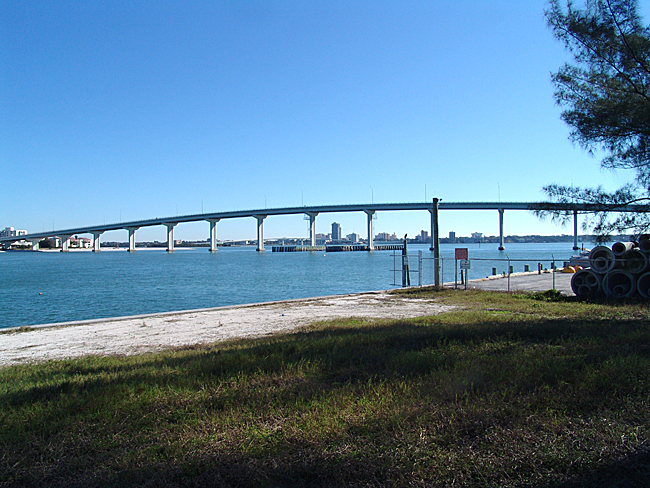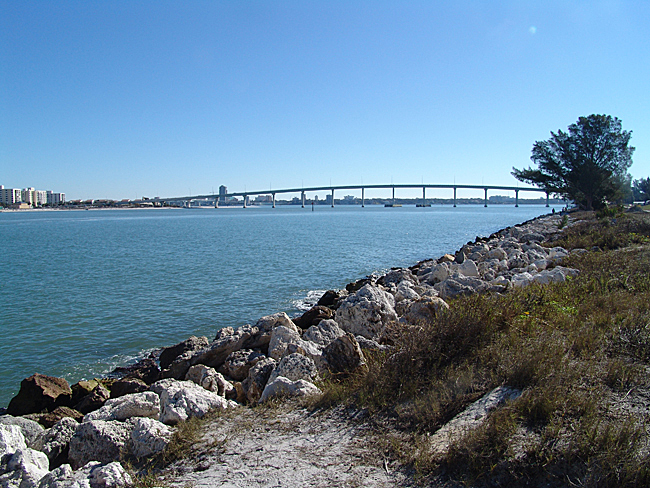|
[
Hump
|
Timeline |
Clearwater Bridge |
Suncoast Trail |
Fort De Soto Park |
Pinellas Trail |
Watts Compared
] Clearwater Bridge this page last updated:
02/01/2015 10:39:06 PM Below is the bridge we used as a hill to get the Widder to understand the following basic concept: Watts is Watts is Watts The first goal for the 2008 23+ Hump season was for the Widder to be able to climb to the top of the Clearwater bridge seated and maintaining 300 watts. I helped her do it by making a guesstimate of the approximate time it would take, then having her practice 300 watt intervals of that length (among other things) on the flat. She could do neither at first and was skeptical, but she soon accomplished the goal and understood completely that it doesn't matter: uphill, downhill, on the flat, into the wind, out of the wind, it just doesn't matter. Watts is watts is watts. Now we use the bridge to test our progress, plus work my own first goal of the season: to stay with Mary all the way to the top as she maintains 300 watts. I have no problem at all doing that on the flat (and for much longer than it takes to climb the bridge), but on the uphill I'm guessing I need about 600 watts to stay on Widder's 300 watt wheel. About three quarters of the way to top, I've had it. Maybe a couple fewer donuts would help.
   Test Procedures North (right>left): 86-99w 6 mile warm-up; maintain into bridge; let the bridge come up on you like the sunrise (slow and easy); should be 300w by start of metal railing; hold wattage to top which is marked by the street lamp pole with the maintenance ladder South (left>right): Maximum watt standing sprint, sit after watts drop.
02/08/08: Regular 6 mile 80-90 watt warmup. Eased into bridge, let watts rise to 300, held it to top. This time I stayed with Mary all the way, and she reported watts of 310. Since, I was still with her at the end, I missed an exact time, because I only hit the timer after I got my wits back about me. On the way home we did one 230 watt interval which the Polar reported as a 23.3 avg, but the Excel calculations placed it at only 21.41. Longer intervals have always provided closer results. Both the bridge climb and the 3 minute 230 watt interval showed slower averages per the Excel calcs. In any case, the interval was with a wind assist, so the 23.3 avg would have to take that into consideration, and it is unclear how much wind there was, because the section where we did the interval was sheltered by the high rise condos, and we experienced a break in the headwind at that location on the way out. After the longer interval Mary did 7 or 8 quick spins at 230 watts not timed to get comfortable with the intensity. Her last was the longest. I had Mary using the skill she has learned from her approach to the bridge (letting the watts catch her as the slope comes up) in order to make her spin up to 230 watts in the quick intervals smooth and efficient. She's getting really good at it, and we we were reaching 26+ paces before she was breaking it off. In fact, she was so efficient and comfortable on the last quick interval that she called it off only because she was getting scared of the speed along a busy part of Gulf Boulevard. I gave her the option of going further, but she started thinking about her recovery so brought the session to an end. During the cool down, she realized it had been the right thing. The Widder is thinking ahead. RESULTS 02/08/08: Bridge out: 310 watts 11.9 avg (14.1 max) (per Excel: 10.59) / Polar: 01:08.1 / 0.2 m / BF avg HR 142 max 153 Bridge in: PB max watts 578 1 interval: 230 watts, 23.3 avg, (24.5 max) (per Excel: 21.41) / Polar: 03:05.7 / 1.1 m/ BF avg HR 144 max 149 wind assist
this page last updated:
02/01/2015 10:39:06 PM |
||||

